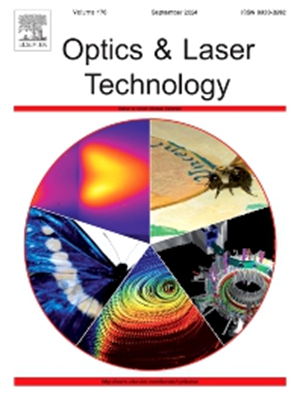Propagation properties and spatial-mode UWOC performance of quasi-perfect optical vortex beam in an improved oceanic channel
IF 4.6
2区 物理与天体物理
Q1 OPTICS
引用次数: 0
Abstract
In this study, the Quasi-perfect optical vortex (Quasi-POV) beam with topological charge-independence radial distribution is investigated to enhance the performance of underwater wireless optical communication (UWOC) system based on spatial modes. Additionally, the oceanic channel model is modified to obtain more reliable simulation results. The propagation and communication performance of perfect optical vortex (POV) beam and Quasi-POV beam are compared and analyzed through the modified model. With the optimization of beam’s parameters, Quasi-POV beam achieves lower bit-error rate (BER) and higher average capacity in multiple phase shift keying (M−PSK) modulated UWOC system. The results indicate that Quasi-POV beam receives higher normalized intensity and lower crosstalk probability than the POV beam, the average simulation results for the three topologic charge cases show that the BER of Quasi-POV beam at 100 m reduced by approximately 52%, the average capacity of Quasi-POV beam increased by approximately 13.3%. The Quasi-POV beam has better performance than the POV beam in Spatial-Mode UWOC system according to the simulation results, which is more suitable for UWOC system based on spatial modes with smaller values of topologic charge.
准完美光涡旋光束在改进型海洋通道中的传播特性和空间模式 UWOC 性能
为了提高基于空间模式的水下无线光通信(UWOC)系统的性能,研究了具有拓扑电荷无关径向分布的准完美光涡旋(准pov)光束。此外,还对海洋航道模型进行了修正,使模拟结果更加可靠。通过修正模型对理想光涡旋光束和准光涡旋光束的传输和通信性能进行了比较和分析。通过对波束参数的优化,准pov波束在多相移键控(M−PSK)调制UWOC系统中实现了较低的误码率(BER)和较高的平均容量。结果表明,准POV波束的归一化强度较高,串扰概率较低,三种拓扑电荷情况下的平均模拟结果表明,准POV波束在100 m处的误码率降低了约52%,准POV波束的平均容量提高了约13.3%。仿真结果表明,准POV波束在空间模式UWOC系统中的性能优于POV波束,更适用于拓扑电荷值较小的空间模式UWOC系统。
本文章由计算机程序翻译,如有差异,请以英文原文为准。
求助全文
约1分钟内获得全文
求助全文
来源期刊
CiteScore
8.50
自引率
10.00%
发文量
1060
审稿时长
3.4 months
期刊介绍:
Optics & Laser Technology aims to provide a vehicle for the publication of a broad range of high quality research and review papers in those fields of scientific and engineering research appertaining to the development and application of the technology of optics and lasers. Papers describing original work in these areas are submitted to rigorous refereeing prior to acceptance for publication.
The scope of Optics & Laser Technology encompasses, but is not restricted to, the following areas:
•development in all types of lasers
•developments in optoelectronic devices and photonics
•developments in new photonics and optical concepts
•developments in conventional optics, optical instruments and components
•techniques of optical metrology, including interferometry and optical fibre sensors
•LIDAR and other non-contact optical measurement techniques, including optical methods in heat and fluid flow
•applications of lasers to materials processing, optical NDT display (including holography) and optical communication
•research and development in the field of laser safety including studies of hazards resulting from the applications of lasers (laser safety, hazards of laser fume)
•developments in optical computing and optical information processing
•developments in new optical materials
•developments in new optical characterization methods and techniques
•developments in quantum optics
•developments in light assisted micro and nanofabrication methods and techniques
•developments in nanophotonics and biophotonics
•developments in imaging processing and systems

 求助内容:
求助内容: 应助结果提醒方式:
应助结果提醒方式:


